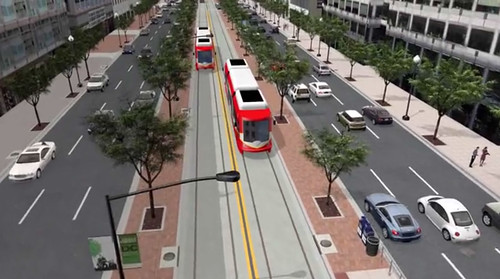The DC Streetcar is drawing a decent number of riders, so far. Compared to other US light rail and streetcar systems, it ranks near the middle in terms of riders per mile of track. It’s slightly above average, neither horrible nor spectacular.
According to DDOT’s latest streetcar ridership report, the H Street line carried an average of 2, 285 passengers each weekday in April. It carries more on Saturdays, but weekday ridership is the standard measuring stick nationwide.
In raw terms, 2, 285 riders per day is pretty low. But for a line that only carries passengers for 1.9 miles, it’s actually not bad.
Middle of the light rail pack
Obviously, the 1.9 mile DC Streetcar isn’t going to carry nearly as many passengers as, say, the 90-mile-long Dallas light rail system. And if you rank all US light rail and streetcar systems by total ridership, DC’s 2, 285 passengers per day is indeed near the bottom, at 31st out of 37. Dallas is 7th with about 105, 000.
But to get a sense of how successful these lines are at attracting riders, we need to compare them on an apples-to-apples basis. To do that, divide the total daily ridership by the number of miles, to get ridership per mile.
And in those terms, DC Streetcar’s 1, 203 riders per mile is a respectable 18th out of 37. It’s just barely in the upper half nationally. And it doesn’t even go downtown yet.
Dallas is actually lower at 1, 164 riders per mile. Other regional light rail systems that are lower than DC Streetcar include Baltimore (691 riders/mile), Norfolk (784), Sacramento (1, 056), Saint Louis (1, 035), Pittsburgh (850), and Cleveland (467).
On the other hand, DC is far below the number one system on the list: Boston’s Green line light rail, which carries a whopping 7, 126 riders per mile. Other systems near the top include San Francisco’s Muni Metro (4, 370 riders/mile), Minneapolis (3, 275), New Jersey’s Hudson-Bergen light rail (2, 852), and the Portland streetcar (2, 723, which is interestingly higher than Portland’s MAX light rail at 2, 048).
Compared to H Street’s X2 bus
What about buses?
In terms of raw riders, the X2 bus on H Street is the 3rd busiest bus line in the WMATA system, with 17, 400 riders per day as of 2015. The X2 is almost exactly 5 miles long, pegging it at 3, 480 riders/mile.
So the streetcar is attracting about one third as many riders as the X2 was before the streetcar started, mile for mile.
But the X2 is a tall order to match. If it were light rail or a streetcar, the X2’s 3, 480 riders/mile would make it the third best system in America, after only Boston and San Francisco. That’s one of the reasons a bigger and nicer vehicle makes sense there in the first place.
Plenty of room for improvement, but riders are there
Clearly the streetcar isn’t perfect. Getting it open was a saga, and its lack of dedicated lanes or traffic signal priority continue to hurt. Future lines absolutely need to be better, and can be better.
And who knows what will happen if DDOT ever starts charging a fare. Atlanta streetcar ridership plummeted when it went from free to $1, but Portland’s streetcar ridership remains high despite adding fares after 11 years of free rides, so that’s hard to predict.
But in terms of attracting riders, DC Streetcar isn’t doing particularly badly.
You can help make sure the next extensions are indeed better by attending upcoming planning meetings, May 17 for the Georgetown extension, and May 19 for Benning Road.
 Comment on this at the version cross-posted to Greater Greater Washington.
Comment on this at the version cross-posted to Greater Greater Washington.
Average Rating: 4.9 out of 5 based on 203 user reviews.

















